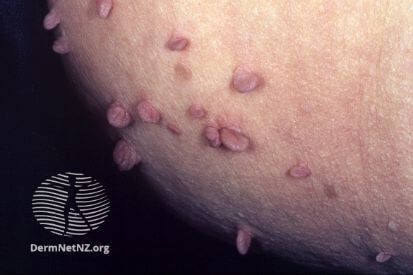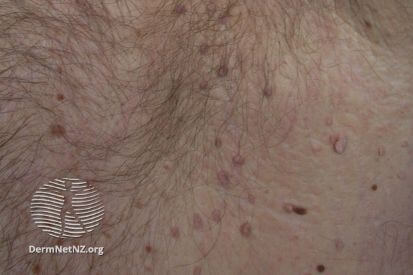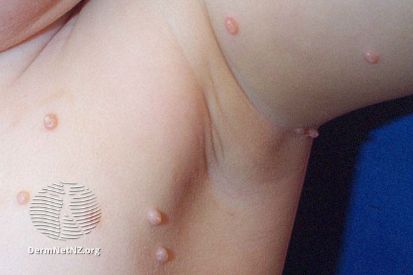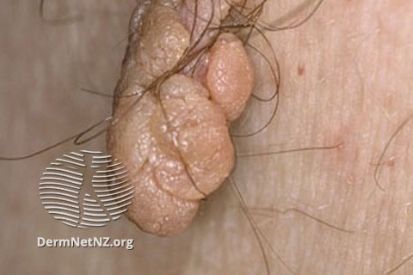Skin Tags
Understanding Skin Tags
Skin tags are small, benign growths that commonly appear on the skin. They are usually soft, flesh-colored, and can range in size from a few millimeters to several centimeters. While skin tags are not usually a cause for concern, they can be bothersome or unsightly for some individuals.
What Are Skin Tags?
Skin tags, medically known as acrochordons, are small, benign tumors made up of skin and connective tissue. They typically form in areas where skin rubs against skin or clothing, such as the neck, armpits, under the breasts, or in the groin area. They are often attached to the skin by a thin stalk.
Examples of Skin Tags




What are the Symptoms of Skin Tags?
- Small, soft, flesh-colored, or slightly darker growths that hang off the skin by a thin stalk.
- Most skin tags are painless and don't cause any symptoms.
Causes of Skin Tags
- Skin-to-skin or skin-to-clothing friction.
- More prevalent in middle-aged and older individuals but can occur at any age.
- There may be a genetic predisposition to developing skin tags.
- Excess body weight can contribute to the development of skin tags, especially in areas where skin rubs against itself.
- Fluctuations in hormones, such as during pregnancy or in individuals with conditions like diabetes.
How to Prevent Skin Tags
Preventing skin tags involves adopting practices to minimize contributing factors associated with their development. Maintaining a healthy weight through a balanced diet and regular exercise can reduce the likelihood of skin tags, as obesity is a known risk factor.
To prevent friction, especially in areas prone to skin tags, opt for loose-fitting clothing and be mindful of accessories that may cause rubbing or irritation. Good hygiene practices, including keeping the skin clean and dry, can also contribute to preventing skin tags by minimizing irritation..
Regular skin checks are recommended to identify and address any new growths or changes promptly, facilitating effective management. It's important to note that skin tags are easily removable if desired.
Skin Tags FAQs
Skin tags can develop due to a variety of factors, including:
- Genetics: A family history of skin tags can increase the likelihood of developing them.
- Weight: Overweight and obese individuals are at higher risk.
- Hormonal Changes: Hormonal fluctuations, such as those during pregnancy, can contribute to skin tag formation.
- Insulin Resistance: People with diabetes or insulin resistance may be more prone to skin tags.
Skin tags are generally harmless and easy to identify due to their appearance and location. However, if a skin tag changes in color, size, or shape, or if it becomes painful or bleeding, it’s important to consult a dermatologist. At Riva Dermatology, we can evaluate any skin changes to ensure there are no underlying health issues.
If you find skin tags bothersome or unsightly, several treatment options are available, including:
- Cryotherapy: Freezing the skin tag with liquid nitrogen.
- Electrosurgery: Using an electrical current to burn off the skin tag.
- Excision: Cutting off the skin tag with a sterile surgical instrument.
Our dermatologists at Riva Dermatology will recommend the best treatment based on your individual needs and preferences.
While there are over-the-counter products and home remedies available for skin tag removal, such as topical treatments or tying off the skin tag with string, these methods are not recommended. At-home removal can lead to infection, scarring, or incomplete removal. It’s safest to have skin tags evaluated and removed by a professional at Riva Dermatology to ensure proper care and minimize risks.
While it may not be possible to completely prevent skin tags, you can reduce your risk by:
- Maintaining a Healthy Weight: Regular exercise and a balanced diet can help manage weight.
- Managing Blood Sugar Levels: Keeping diabetes and insulin resistance in check may reduce skin tag formation.
- Reducing Friction: Avoiding excessive rubbing in areas where skin tags commonly occur, such as the neck and armpits.
For personalized advice and to discuss your skin tag concerns, contact Riva Dermatology to schedule a consultation with one of our experts.
How to Treat Skin Tags
- Excision: Dermatologists may cut off skin tags using surgical scissors or a scalpel after numbing the area with a local anesthetic.
- Cauterization: This involves burning off the skin tag using electrical current (electrosurgery) or a high-frequency laser.
- Cryotherapy: Freezing the skin tag with liquid nitrogen, causing it to fall off over time.
Featured Products

CLn BodyWash
CLn BodyWash is designed for infection- and eczema-prone skin. It is an effective cleanser that is tough on the microbes but gentle on skin. Designed for skin prone to infection, irritation, dermatitis, redness, folliculitis, acne, eczema and compromised skin. 12 fl oz / 354 mL

Epionce Purifying Toner
Purifying Toner helps remove traces of dirt, oil and makeup. Botanical ingredients reduce surface shine while helping control factors that can lead to the visible appearance of problem or irritated skin. Set at optimal pH.


